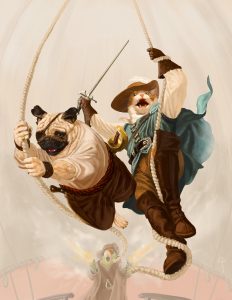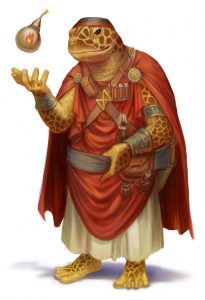
This is a preview of the new material on Lizard species featured in Pirates of Pugmire, currently on Kickstarter.
The lizard families are still elusive and mysterious to most dogs and cats from Pugmire and the monarchies. They tend to live in nomadic bands, traversing the more arid regions of the world, though a pawful can be found scattered throughout any major city, and their caravans stop in border cities and settlements with some frequency to trade supplies, goods, information, and messages. Lizards rarely settle down in one place, and those that do are referred to by other members of their species as “hibernal.” Though it’s not common, it’s also not looked down upon, and lizards will often visit their hibernal family members when they come to town or the few small, permanent lizard settlements to trade, bringing tales of their travels since the family was last together.
Lizards are consummate storytellers. In their low-pitched, pleasantly articulate tones, they spin tales about places and wonders of which the most imaginative cat might only dream. It’s not uncommon for a young dog or cat to choose to lead a life of adventure after hearing a lizard storyteller speak of far-off destinations and ruins filled with plastic. Finding those ruins based on the embellished yarns of a traveling lizard, however, is often a much harder proposition than they expect.
Though most denizens of Pugmire and the monarchies think of the lizards as belonging to “tribes,” that’s a term they applied out of ignorance of lizard culture. Lizards themselves refer to their bands as “families,” regardless of what kinds of lizards are in the family, and whether they are related. Many lizard families comprise all three types of lizard — geckos, turtles, and serpents — and they all look quite different. Often, a cat or dog seeing a lizard family for the first time is struck with confusion over the fact that its members look drastically different from one another, even more so than most groups of cats, dogs, or rats and mice.
Even the term “lizard” is not truly correct. Much like the nomenclature of the “badger tribes,” which include weasels and all polecats, “lizard” is a blanket term that most species in the world use to mean “smooth-skinned one.” The term is even occasionally used to bully young kittens who are naturally hairless, though if any adult hears the taunting, they will almost always cuff the young one gently on the ear and remind them that being different isn’t a bad thing. Smooth-skinned, furred, or feathered, everyone looks the way they are supposed to.
On the inside, lizard culture is as rich and full of history as the cat and dog kingdoms. Though there has never been a true lizard ruler or ruling council, each family has a matriarch to whom they turn to settle disputes and lead the way. Whenever more than one lizard family gathers in the same place, the matriarchs will meet in private over the course of one to several evenings, swapping information, secrets, and news that need to be spread across all the lizard families. This whisper network ensures all lizards are up to date on the doings of each family, and know who to watch out for, which places to go and which to avoid, and if there are any families that require aid.
Though they can appear standoffish, lizards are anything but. They merely have a culture that depends quite heavily on their ancestral rituals and customs. Their ways may seem odd or mysterious to strangers, but most of their greetings and offers of hospitality are simple at their root. If a cat or dog approaches a colorful lizard encampment or caravan, they will be offered a small dish of salt, which is very important to lizards. The cat or dog is expected to taste the salt, and the lizard will do the same. Once this ritual is completed, and various niceties are exchanged, the visitor will be treated after as an honored guest unless they commit a terrible faux pas. Lizards eat communally as well and expect guests to at least sample each dish placed before them, even if it is a food with which they are unfamiliar. It is perfectly fine to decline after the initial taste, but trying the food indicates trust among the lizards, and if their guest doesn’t trust them, why should they trust their guest?

Salt is important to lizards for a few reasons. Most families make pilgrimages every few months to the salt pan ruins to restock, for the mineral is used as a seasoning, a means of water retention in the arid climes, and as a component of both their religious rites and their alkalists’ magic. If a family falls on hard times, they are said to have “run out of salt,” and other families will do their best to assist.
Naming conventions among lizard families are also fairly easy to understand. A lizard’s parent gives them a first name but when they come of age, they choose their own first name. Their surname is always the name of their mother with “childe” attached to the end, so a lizard named Kaitha who is the daughter of Ranu will be Kaitha Ranuchilde. If she has offspring, their last name will be Kaithachilde. Lizards use the term “clutchmate” to refer to a lizard to whom they are blood related, whether sibling, mother, or great-uncle. This can cause confusion among other species, but lizards don’t place as much stock in lineage as some do — the enjoyment they get from confusing outsiders is purely secondary.
Lizards do not generally think much about the Old Ones. The main thing they worship is the sun, as it gives them energy and makes the plants grow. Lizards are not very religious in any case, and their sun worship is more spiritual than theological. They are known to sit on stones and meditate when the sun is at its zenith, soaking in the warmth and clearing their minds. Pirate lizards may be found in clear spots of deck at this time, but they won’t be overly irritated if they are disturbed. Lizards are calm, though if they get agitated, they can be as quick to rouse as anyone else.
As far as dress, lizards wear whatever best suits the climate. In warm or tropical places, they are usually found in flowing, comfortable garments in white and other light colors, and in colder area they prefer furred hats and greatcoats. They usually keep their faces covered outside of their own communities, mostly because of their own hospitality rules. Most hibernal lizards, and many pirates, forgo this custom in favor of blending in.

Comments
2 responses to “New Species: Lizard [Pirates of Pugmire]”
Still no bird races???
Here you go.
https://www.kickstarter.com/projects/200664283/pirates-of-pugmire-a-realms-of-pugmire-tabletop-rpg/posts/2518537